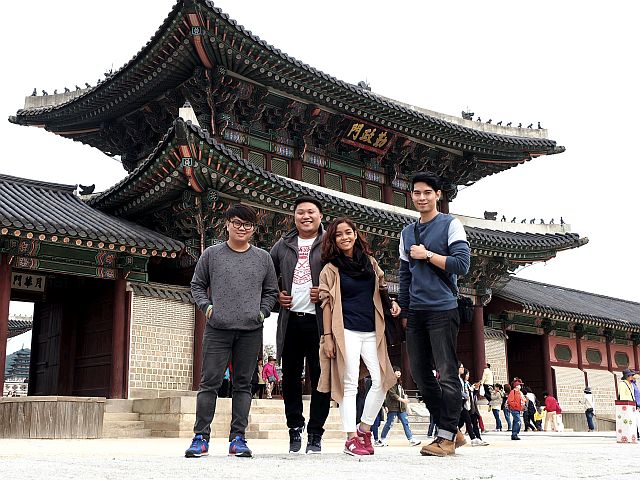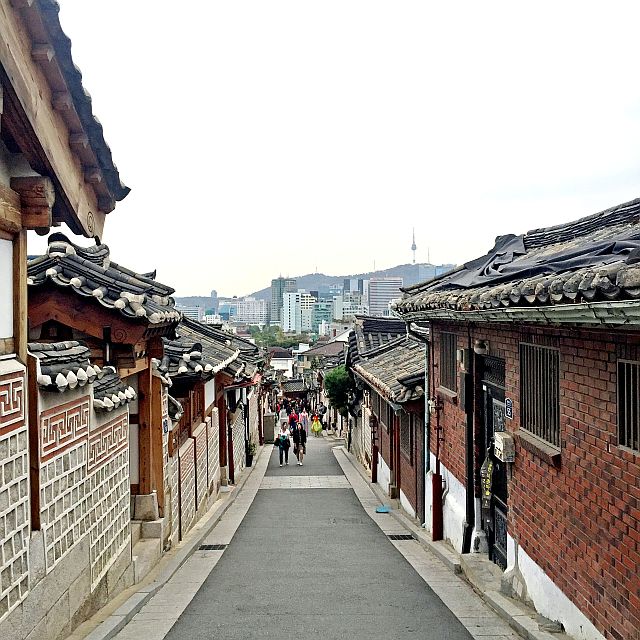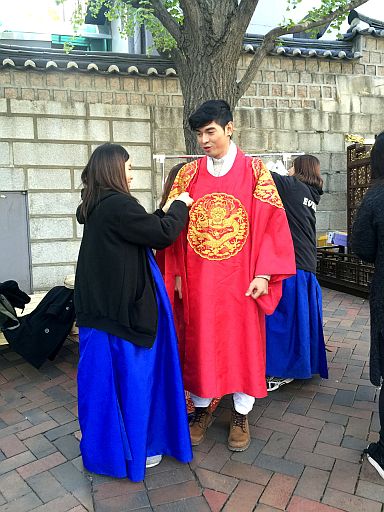
The writer (extreme right) with (from left) Marco Diala, Ethelbert Ouano, Jeemah Villaverde at the Gyeongbukgong Palace.
WHEN the leaves start to change colors and the temperature begins to drop is a good time to explore Seoul and beyond.
On the week of my first autumn experience in my first adventure in South Korea, I found myself transported into the world of Koreanovelas, and immersed in the fascinating culture of Seoul.
Seoul is a five-hour direct flight from Cebu. The capital city of the largest metropolis of South Korea offers its visitors a juxtaposition of its yesteryears and the present. From the exquisitely preserved Gyeongbokgung Palace to the soaring N Seoul Tower, it’s apparent that SoKor’s capital thinks highly of its past, yet keeps up with modern times.
My friends and I vacationed in Seoul at the outset of autumn last year. The temperature started to dip to as cold as 10 degrees Celsius and the trees have turned orange, yellow, purple, pink, brown and red. Believe me, it’s a sight to behold.
Seoul was celebrating Korea Grand Sale, which happens every October. The whole metro attracts hordes of visitors, both domestic and foreign, during this time, not just to visit tourist spots but also to hunt for the best deals in town.
Around Seoul
Gyeongbokgung Palace, which houses Korea’s National Palace Museum and the National Folk Museum, can be toured in less than three hours. But if you can, a leisurely stroll around the palace grounds and exploring both museums inside the compound is truly well worth your time. Then you’ll get an overview of Korean history, culture and architecture. And yes, don’t forget the Sumunjang (Royal Guard) Changing Ceremony at 10 a.m. at the Gwanghwamun gate. If you missed the first show, another one happens at 2 p.m.

Bukchon Hanok Village is a Korean traditional village in Seoul
From Gyeongbokgung Palace, we walked to Bukchon Hanok Village. It is home to hundreds of traditional houses or hanok, that date back to the Joseon Dynasty. “Bukchon” translates to “northern village,” which suggests its location as the neighborhood that lies north of Cheonggyecheon Stream and Jogno—both significant Seoul landmarks. Currently, these hanoks operate as tea houses, restaurants guesthouses and cultural
centers, providing visitors an experience of Korean culture. Gyeongbokgung Palace and Bukchon Hanok Village can be incorporated on a day’s tour.
The next morning, we had an early cup of coffee near our rented Airbnb apartment, then swung by for a quick stopover at Sungnyemun Gate. Also called Namdaemun Gate, it’s Korea’s National Treasure No. 1. It is the largest castle gate stone structure with an arched entrance. That day we did a side trip outside of Seoul to Nami Island.

Getting dresed in hanbok
On the third day we went to the mountains of Ingwansan and Namsan. The sunlight was intense, but the cold wind tempered the heat. First on our itinerary was an early morning Ingwansan hike.
Ingwansan Mountain is the ritual grounds of King Tajeo and Muhakdaesa. The castle wall built on the outskirts of Seoul, stretching from the Sajik Tunnel to Jahamun, can still be found on the grounds of Inwang. Along the route, we were treated to beautiful sceneries, including murals leading to a nearby temple. We spent over two hours at the peak, enjoying the fresh, cool breeze while marveling at the overlooking view of the metro.
After a Korean barbecue late lunch, we went back to the apartment for a quick rest and to change. Dressed up for a fancy dinner at the Iconic Seoul Tower, we hopped on the cable car and alighted at Namsam Mountain. A few meters from the tower is a viewing deck where lots of couples, along with group of friends and families, come by to seal their love through padlocks. It sets up a romantic mood, and the chilly weather conspiringly totted up to the whimsical scene.
A few minutes walk from the Love Locks deck, we arrived at the foot of the N Seoul Tower —standing 236.7 meter high on top of Namsan Mountain. We then went up the tower’s third floor to the Observatory, granting a scenic night view of the metro. Famished from the day’s hike, we went for a fancy Korean feast at the Hancook Restaurant.
It’s a good thing Seoul was celebrating Cultural Week during our visit. We got to immerse in traditional culture in half a day at one venue. We were taught how to do the traditional Korean block printing, properly write on fortune slips and how to tie them, prepare potpourri pockets, get dressed in traditional Hanbok, witnessed cultural performances and mingled with the locals.

